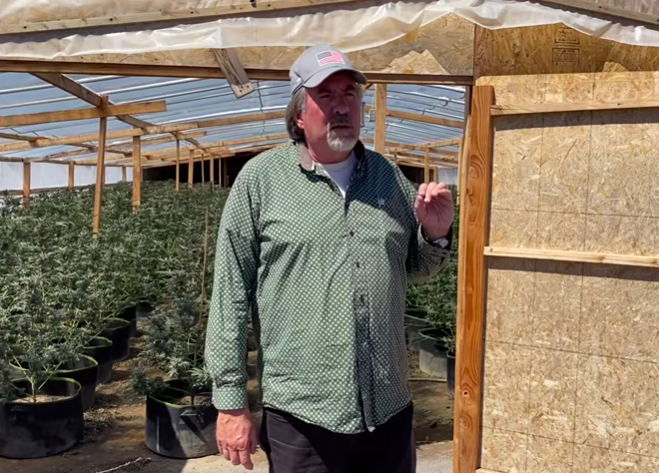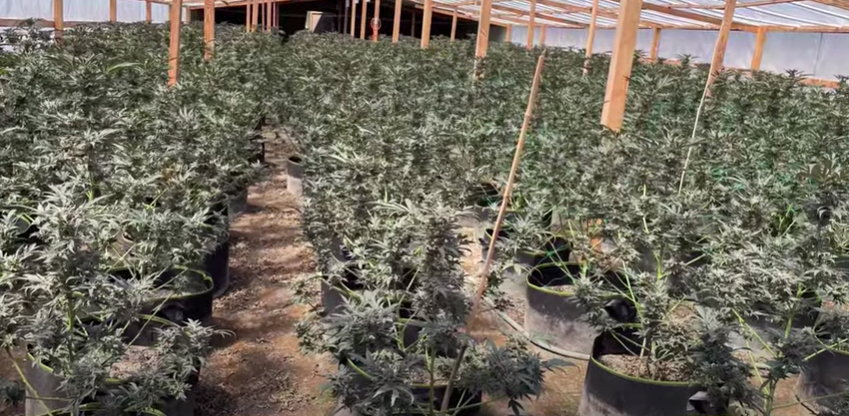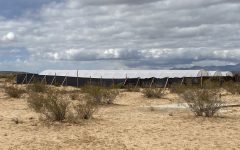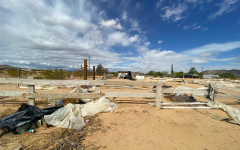
Rep. Doug LaMalfa (R-CA) at an illegal marijuana grow. (Photo: screen capture LaMalfa youtube)
Rep. Doug LaMalfa Highlights Need for Active Forest Management and Crackdown on Illegal Marijuana Grows
LaMalfa made video series exposing organized crime illegal marijuana grows in Siskiyou County
By Katy Grimes, July 23, 2021 4:44 pm
With the federal Resilient Federal Forests Act introduced this week with the support of more than 70 bipartisan Members of Congress and over 85 organizations, California Congressman Doug LaMalfa stressed that California is a poster-child for what not to do – little to no forest management, and illegal marijuana grows in those forests and rural areas. “Communities across the West are being devastated by wildfires and there will be long-term negative impacts to our forests, our water quality, and wildlife habitat,” LaMalfa said. He noted that it is Republicans in Congress proposing solutions to help prevent the catastrophic wildfires California experiences annually now. He also said Democrat leadership has been ignoring this issue.
LaMalfa knows what he’s talking about as a lifelong farmer representing California’s First Congressional District, which includes the rural counties of Butte, Glenn, Lassen, Modoc, Nevada, Placer, Plumas, Shasta, Sierra, Siskiyou and Tehama.
Key provisions of the Resilient Federal Forests Act include:
- Utilizing state-of-the-art science to triage the top 10 percent of high-risk fire sheds.
- Simplifying and expediting environmental analyses to reduce costs and planning times of critical forest management projects while maintaining thorough environmental reviews.
- Speeding up essential forest management projects by ending frivolous ligation.
- Giving the Forest Service the necessary tools to restore watersheds, improve wildlife habitat and protect critical infrastructure and public safety in wild land-urban interfaces.
- Accelerating reviews for salvage operations and reforestation activities to encourage quick reforestation, remove dangerous hazard trees and economically revitalize rural areas.
- Incentivizing collaborative projects of up to 30,000 acres to increase the pace and scale of active management.
- Creating new, innovative authorities that increase tribal management of forestlands.
- Codifying the principles of shared stewardship and permanently reauthorizing the Good Neighbor Authority to ensure states are equal partners in forest management activities.
- Removing cumbersome interagency consultation requirements that delay forest management activities and attract obstructionist litigation.
- Expanding and improving existing authorities to address insect and disease infestations and increase resiliency to wildfires.
According to the House Committee on Natural Resources, more than 80 million acres of national forests are overgrown, fire-prone and in dire need of active management. The Resilient Federal Forests Act would facilitate the restoration of forest health, increase resiliency to wildfire, and support the economic revitalization of rural communities.

Also impacting California’s vulnerable forest lands are illegal marijuana grows. LaMalfa said in Siskiyou County, there are 4,000 marijuana grows.
Land has been illegally subdivided then scraped bare with the dead trees, rocks and topsoil piled into berms on all sides to mark the edges of the grow and reduce the ability to see into it. The Siskiyou County Board of Supervisors has created ordinances restricting water to the illegal actives in the area while ensuring people can have water for personal needs. Protests have erupted as criminal growers found themselves without water to finish another growing cycle and the prospect of losing millions of dollars in illegal sales evaporate in the drought conditions of Northern California.
LaMalfa made a series of videos to heighten awareness of increasing organized crime infiltrating rural California to set up illegal marijuana grows to export the drug to other states.
LaMalfa says that nothing about these grows are legal under California law or county ordinances. “With limited resources and facing well-funded and well-armed criminal organizations, rural counties have struggled with being able to effectively respond to the growing environmental crisis these grows create. Illegally used pesticides, fertilizers, fuel, trash, and human excrement litter once pristine lands.”
“I went to see firsthand the massive amount of organized crime and illegal cartel grow operations overwhelming Siskiyou County,” LaMalfa said. “The rapid growth of this criminal enterprise was staggering. Just a few years ago the area was sparsely populated with juniper and scrub brush dotting the rocky hillsides at the base of Mt. Shasta. Now, thousands of illegal grows have filled the landscape with large greenhouses.”
“Trash, illegally used pesticides, human waste and fuel cover the ground that has been scraped bare of organic matter with nothing but dust left,” LaMalfa said. “These grow sites are destroying our environment. Local wildlife is now nonexistent in the area. This level of criminality cannot be tolerated.”
LaMalfa noted that most of the residents of Siskiyou County want to see the illegal grows eradicated.
A court order won by District Attorney Kirk Andrus allowed a portion of the over 4000 illegal grow sites to be bulldozed and begin environmental remediation. This is LaMalfa bulldozing the grows:
LaMalfa said Siskiyou County has been ground zero for organized crime setting up illegal pot growing operations, which brings in gang activity and rival gangs,
Sheriff Jerimiah LaRue is enforcing the water limitations into the grow areas has been effective in reducing some of the criminal operations. Siskiyou County needs the help of the Federal and State government to help solve this problem.
In the video (below) Rep. LaMalfa is with Siskiyou County Sheriff Jerimiah LaRue and Siskiyou County Supervisor Ray Haupt. The Globe had the opportunity to interview Supervisor Haupt September 2020 after he participated in a meeting with President Donald Trump, Gov. Gavin Newsom and state and local officials in Sacramento, CA to discuss the 2020 wildfires. In addition to having a Bachelor of Science degree in Natural Resources Management and Forestry, a certificate in Logging/Transportation Engineering and Economics, Haupt retired in 2010 as District Ranger on the Klamath National Forest after 33 years of federal service. Since retirement Haupt has worked with the U.S. Congress on several Natural Resource bills, is an active member of SFAC (Sustainable Forest Action Coalition), Director of Water Yield Research in Sugar Creek with UC Berkeley and UC Merced, is the Science Chair for the Elimination of Catastrophic Wildfire, and teaches Forest Science courses at College of the Siskiyous in Weed.
- AG Bonta Promotes California’s ‘Migrant Community’ Over California Citizens - December 20, 2025
- HHS Acts to Bar Hospitals from Performing Sex-Rejecting Procedures on Children - December 19, 2025
- Top 50 Disasters Gov. Gavin Newsom Has Ushered into California: 2025 Edition - December 17, 2025





Where is the Governor and the Legislature regarding the mobilization of the California National Guard to help clean up this mess?
P.S. Watching the videos makes me feel like buying a D5 Bulldozer and going up to Siskiyou County to help LaMalfa knock down these illegal grows.
When will the leftist environmental devastation end? No doubt every single grower has a save the whales and Sierra Club bumper stickers yet they see no problem with killing all the wildlife, cutting down the trees and poisoning the streams so they can get high.
Why do you assume that illegal growers are “leftist environmental[ists]”? The people who get busted “hard” don’t have cannabis as their only crop; they’re cooking meth in the same locations (as the Sheriff suggested…) because they feed the same illegal distribution channels. None of these people look like Sierra Club or Save the Whales types… they are more like uncontrolled hyper-capitalists.
The “real” problem here is that setting up a legal grow operation takes way too long and costs way too much money to get. That’s what makes illegal growing attractive.
As far as the Shasta Vista subdivision that LaMalfa refers to, it was legally subdivided many years ago because
it was very poor grazing land with a lack of water.. Many lots went unsold for decades. All of the accessible forested lands burned in the Lava Fire, both public and private, have been logged, often several times. Management is not the problem. Heat and drought are.